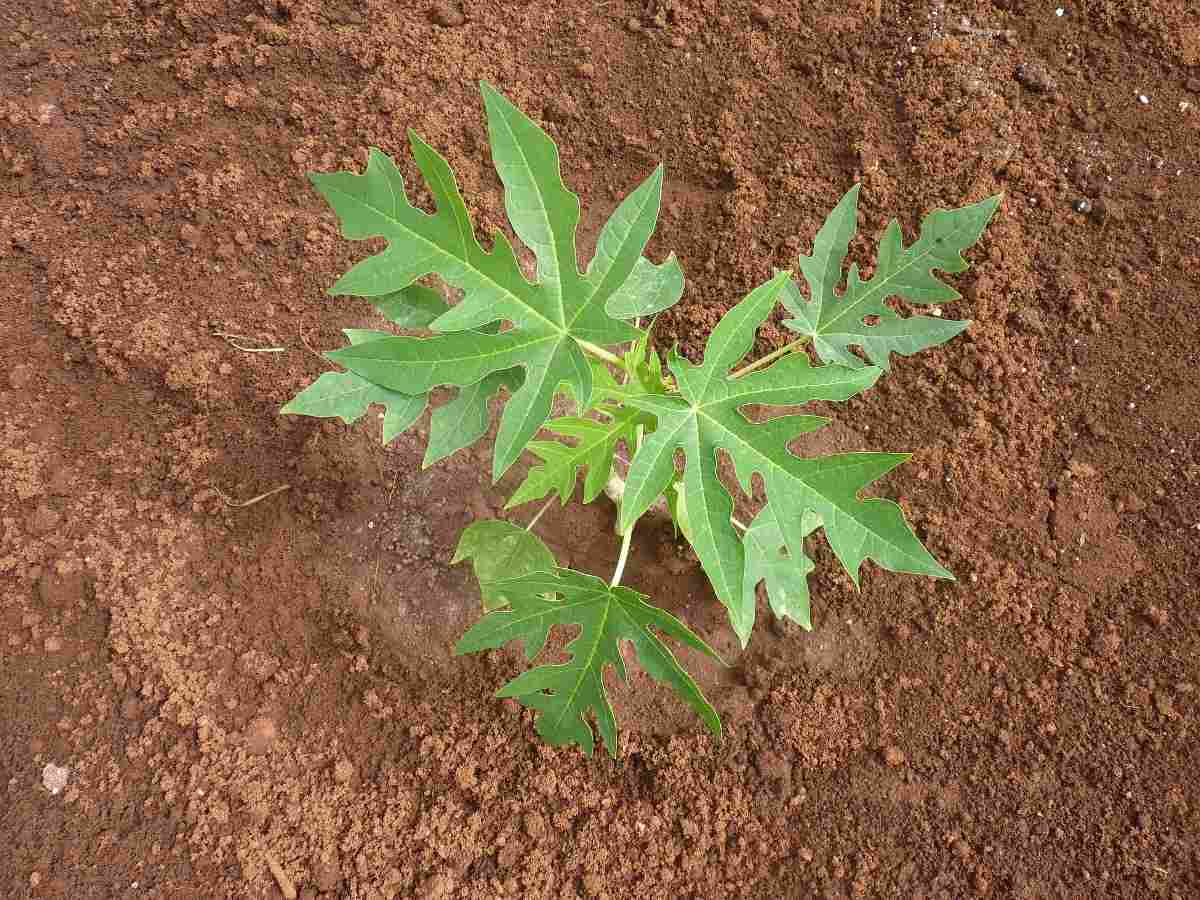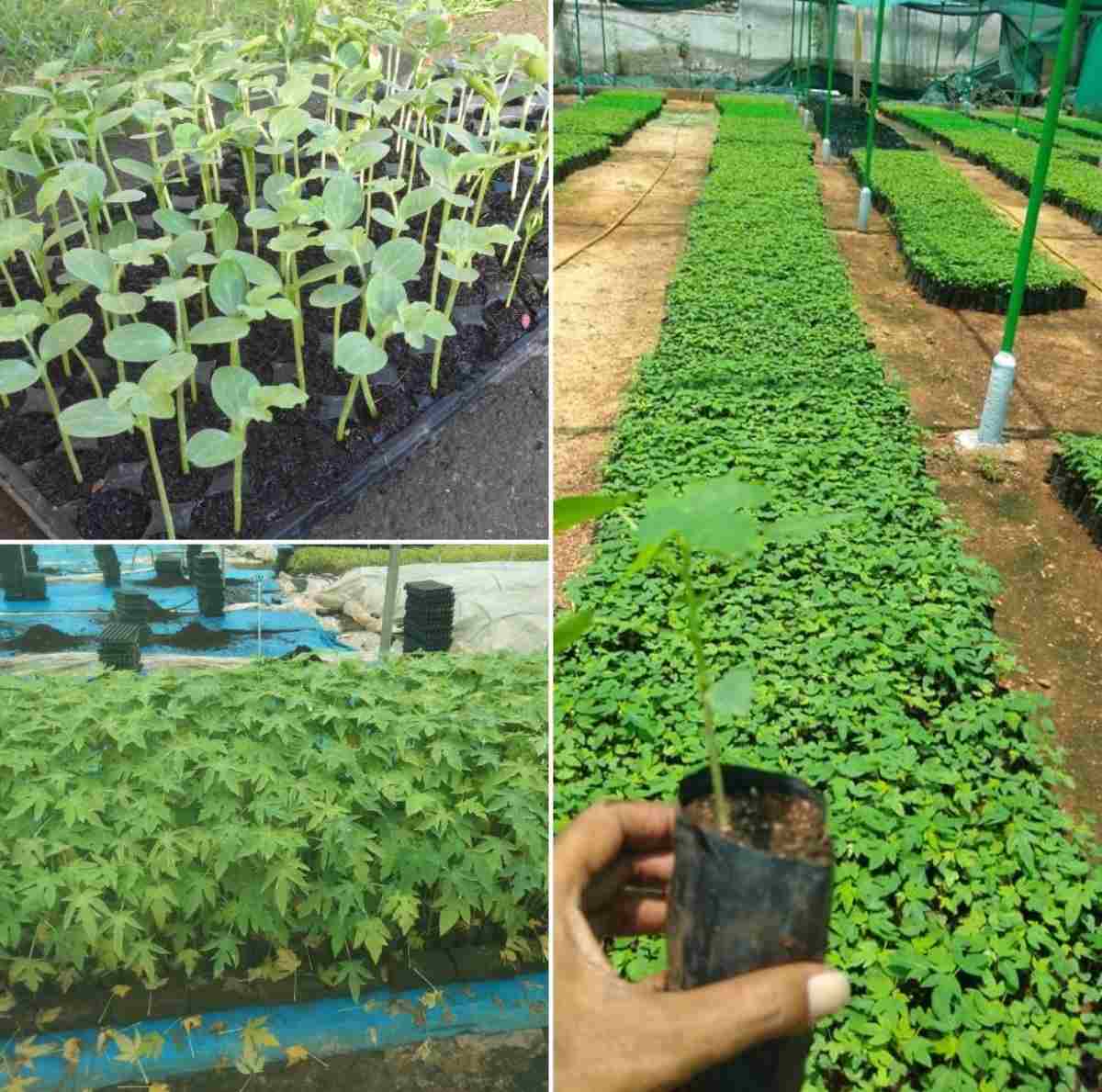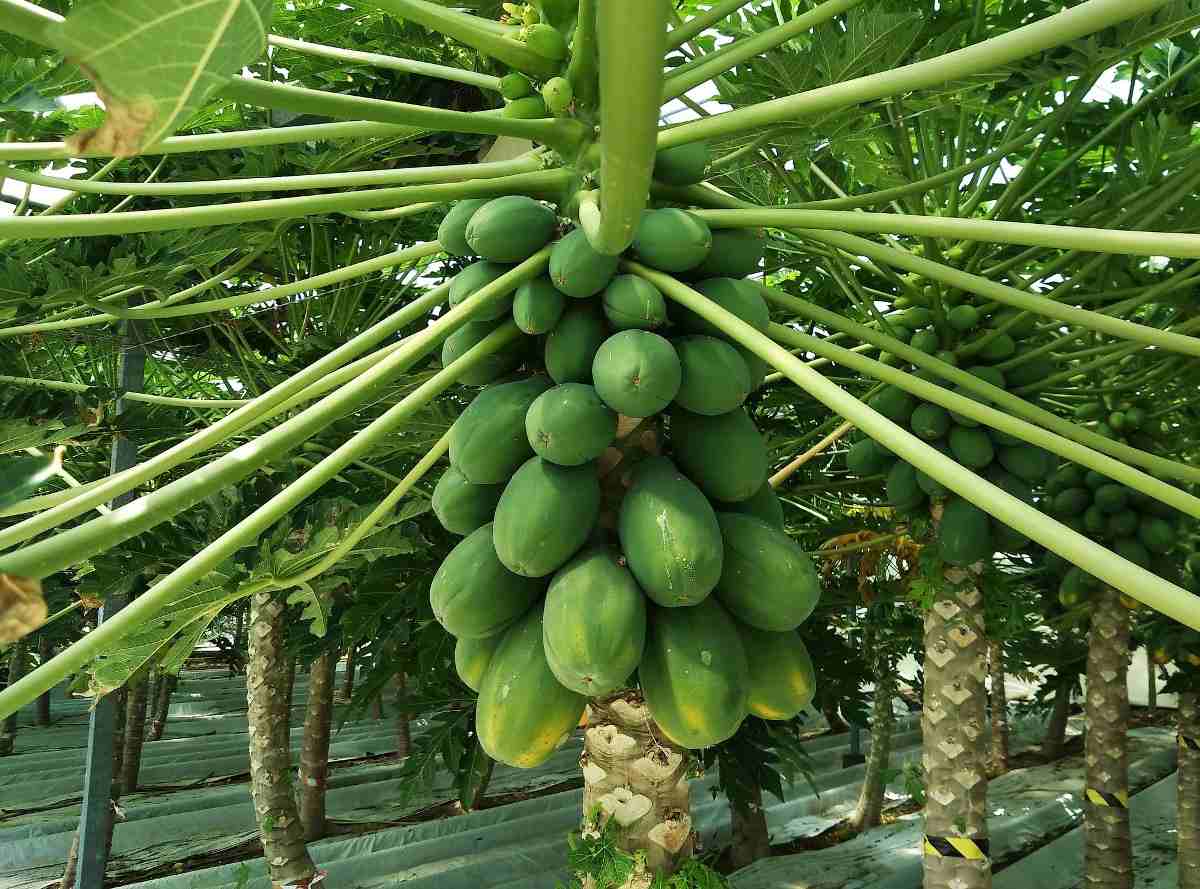Papaya seed germination: The papaya tree is a fast-growing, short-lived, and tropical tree. Papaya belongs to the family Caricaceae and botanically called as Carica papaya. Papaya is one of the important fruit crops of Hawaii, Malaysia, Burma, Sri Lanka, India, Queens Land, South Africa, and other tropical and sub-tropical countries of the world. Papaya fruit occupies 2.0 percent total fruit crop area and 5.3 percent of total fruit production in India. The plant’s fruits could take on a variety of shapes, including pear-like or round, and are known for their sweet, yellow or orange flesh.
In this article we also discussed;
- Papaya seeds germination time
- Process for germinating papaya seeds
- Papaya paper towel seed germination
- Papaya seeds germination temperature
- Process of growing papaya from seed
- Papaya seeds germination period
- Tips for papaya seeds germination
- Reason for not germinating papaya seeds
A step by step guide to papaya seed germination period
Now Let us learn the seed germination process of papaya, papaya seed germination time, ideal temperature for papaya seed germination, and growing papaya from seeds.

Growing papaya from seed
Propagation by seed is the universally followed system of multiplication in papaya. Though this method does not safeguard the purity of the progeny, it is inevitable as of the absence of any commercially feasible vegetative propagation technique. With the commercialization of papaya cultivation, the demand for quality seeds of well-established plant varieties has increased. Few attempts have been made in the past to increase effective methods of producing quality seeds and maintain their viability. While, growing Papaya from seed is an exercise in patience, as the seeds are slow to germinate and want special care. In the wild, Papaya trees naturally grow as understory trees. Germinating Papaya seeds and young seedlings of pawpaw are extremely sensitive and even killed by direct sunlight. To successfully grow Papaya from seed, you will need to provide them with some shade for the first year or two.
You should not miss the Organic Farming Training, Organic Farming Courses.
Different varieties of papaya
Some varieties of papaya can be Pusa Nanha, Pusa Majesty, Pusa Delicious, Pusa Dwarf, Pusa Giant, Surya, Co-1 to Co-8, Arka Prabhat, Coorge Honey Dew, Washington, Solo varieties, Ranchi, RCTP-1and Red Lady. Also, Red Lady, and RCTP-1 perform well.
Climate and soil condition for growing papaya
Papaya is a tropical, plant, sensitive to frost. Optimum temperature range is 25 – 30°C and minimum 16°C. The suitable pH value for papaya is between 6 and 6.5. The well-drained or sandy loam soil with adequate organic matter is important for the papaya cultivation. In high rainfall area, if drainage is poor and roots are continuously drenched for 24 to 48 hours, it can cause the death of the plants. Sticky and calcareous soils are not good as rainwater could accumulate in the soil even only for a few hours. In this case, a higher raised bed and also drainage ditch are recommended.
The growing field must be irrigable and kept at suitable soil moisture which is necessary for the growth of papaya. Continuous cropping in the same field can result in poor growth and cause disease problems of papaya trees. Papaya plant does not like the strong, cool, hot, dry or salty wind. And it is better to grow in sheltered but full sunshine place.
Prepare your soil for growing papaya – Choose a nutrient-rich potting mix for tropical plants, or make your own mix out of garden soil and 25 to 50% compost. As long as the soil drains well, the exact soil texture doesn’t matter and papaya will grow in sandy, loamy, or rocky soils.
If you are able to test soil pH level or you are choosing between commercial potting mixes, select a soil with a pH between 6 and 6.5. This is a broad range, so it is likely that any soil that successfully grows other plants in the garden has the correct pH for papaya.
If you want more of your papaya seeds to germinate, use a sterile potting mix. You can make your own by mixing one part vermiculite and one part potting mix and baking this mixture in the oven at 200°F (93°C) for one hour.
Planting material for growing papaya
Papaya is commercially propagated by seed and by tissue culture plants. The seed rate is 250 to 300 grams/ha. The seedlings can be raised in nursery beds 3meters long, 1meter wide and 10 cm. high as well as in pots or in polythene bags. The papaya seeds after being treated with 0.1% Monosan (phenylmercuric acetate), and ceresan, etc. are sown 1 cm. deep in rows 10 centimeters apart and covered with fine compost or leaf mould. The light irrigation system is provided during the morning hours. The nursery beds are covered with polythene sheets to protect the seedlings. About 15 to 20 cm. tall seedlings are chosen for planting in about 2 months.

Seed source and requirement for growing papaya
The papaya seed should be from a dependable source and sown as soon as possible. The remaining seeds must be sealed tightly and kept at cool about 5 -10°C and dry (under relative humidity 40%) place.
One gram contains about 50 to 80 seeds, mostly 65 -75 seeds. And it needs 50 to 80 grams seeds per hectare at one plant per hill average of 80% seed germination and 80% successful seedlings.
You may also like the Flour Mill Project Report, Cost, Subsidy, Permission.
The proper way of papaya seed germination
Papaya seeds germinate slowly because they possess dormant embryos and slowly permeable seed coats. The germination process can be improved by placing the seeds in a cool, moist environment for 80 to 100 days. The cool, moist requirement can be met by placing the Papaya seeds in a moist 50:50 mixture of sand and peat moss and then placing the seeds in the refrigerator. After 80 to 100 days, remove the papaya seeds from the refrigerator and plant in potting soil. Keep the potting soil evenly moist and warm about 70 to 75°F until the seeds germinate. Germination of papaya seeds tends to be slow and erratic.
Seed germination of papaya
The optimum temperature range is 21 – 27° C, and of radical emergence is 19 – 29 °C. It takes 1 to 4 weeks from sowing to emerge depending on the temperature range. The fresh seed is extracted from matured papaya fruits which had high initial moisture content that was dried to a safe moisture content of about 8% by spreading on open-air trays. The seed germination test was carried out in double chamber seed germination. For alternate temperatures, the lower temperature was maintained for 16 hours and a higher temperature range for 8 hours each day. The germination paper being used in the study was porous and free from toxic chemicals and water-soluble dyes. For the seed germination process, the rolled towel method was used. The rolled towels were placed in a slant position in the germinator maintained at the necessary temperature levels.
The germination test was conducted for seeds by employing the “Between Paper” process. The germination counts were taken every day until the completion of the germination process. The cumulative germination process was calculated on the basis of a number of seedlings germinated on each day.
Paper towel seed germination method
The paper towel method for seed germination is very easy. It provides an excellent medium for the germination of papaya seeds and the paper towels tend to be free from pathogens. Also, it makes it easy to control the moisture levels, thus, facilitating the proper germination of seeds.
To perform the paper towel germination method, the following things are important;
- Container with a lid
- Paper Towels
- Seedling Heat Mat
Process of paper towel germination method for papaya seed germination
Wet the paper towel – Don’t get it dripping wet, just carefully dampen it. Place the papaya seeds on the paper towel and fold it over the seeds. Place the papaya seeds inside of the container and close the lid. Put the container on top of the seedling heat mat or some other source of heat. Make sure the container is light-proof and if it isn’t light-proof, and then place it in a dark area.
- Rip off a square of quality paper towel for the seed germination process
- Wet the paper towel and then squeeze it so it’s moist but not dripping.
- Place your seeds on the paper towel and fold it over.
- Put a folded paper towel in Ziplock bag or cover in cling wrap.
- Place on the sunny window sill.
- Check progress in 3 to 5 days.
And do not soak the paper towels, because the combination of too much water quantity, no light and warmth can encourage mold, which can harm your seeds.
Planting process of papaya seeds
Even when provided with adequate shade, germinating papaya seeds requires a 60 to 100-day period of cold, moist stratification. Plant seeds are sown directly in the ground, or in deep tree containers in late fall after the seeds ripen in fall. Stratification can be mimicked in a refrigerator at 32-40°F. Then seeds should be placed in a Ziploc bag with moist, but not wet, sphagnum moss and sealed. Seeds must be kept in the refrigerator for 70-100 days. Once removed from the refrigerator, the seeds can be soaked in warm water for 24 hours to break dormancy, and then planted in the ground or in deep containers.
Seedlings usually sprout a month or two after germination but aerial growth will be slow for the first 2 years as the plant expends most of its energy into root development. They prefer well-draining, slightly acidic soil in the pH range of 5.5 to 7. In heavy clay or waterlogged soils, papaya seedlings will not perform well and may die. Proper drainage is necessary for optimal growth. Papaya trees also do not transplant well, so it is important to plant pawpaw seeds in a site where they can permanently stay, or in a large enough container where they can grow for some time. Papaya seeds, like their fruit, have a very short shelf life. Papaya seeds should never be stored by drying or freezing. In just 3 days of drying, pawpaw seeds can lose about 20% of their viability. Seeds ripen in fall (September to October) and removed from the fruit, washed, and used immediately for seed propagation.
In case if you miss this: Post Harvesting Technology of Fruits for Dummies.
Important steps to improve papaya seed germination will be;
- Mix 100 grams of potassium nitrate in 1 liter of water (3.4 ounces in 1 quart).
- Soak seeds for 30 minutes.
- Plant immediately after soaking.
Water papaya seedlings
Water papaya seedlings and then established plants regularly. Papayas can be simply damaged by standing pools of water, but may not produce sizable fruit without regular water access. If planted in loam that holds water well, water no more than once every 3 or 4 days. In sandy or rocky soils, increase this to once every 1 to 2 days during hot weather. Allow a few more days in between watering during cooler seasons.
Usually, irrigate every 10 days in winter or every week in summer, but practice varies according to the soil, climatic conditions, and irrigation methods. Ring method, furrow or drip irrigation method can be done. To prevent the water from coming in contact with the stem. Irrigation could prevent the plants from the damage of frost.
Fertilizer for papaya plants
Papaya plants need a lot of fertilizing. They are particularly greedy for nitrogen and fertilize them regularly. You can use a complete fertilizer, or like chicken manure. Papaya plants handle strong or fresh manures fairly well. You should be generous with compost, and just keep piling on the mulch as the plants grow bigger.
Papaya plant protection measures
Pests – There are some pests that can cause damage and spoil the fruit production. The pests in papaya fruits are whitefly, fruit flies, aphids, red spider mite, ash weevils, and grey weevil. Then the infected plant parts want to be destroyed along with the application of prophylactic sprays of Dimethoate (0.3%) or methyl demeton (0.05%).
Diseases – The main plant diseases reported are powdery mildew (Oidium caricae), anthracnose (Colletotrichum gloeosporioides), and damping-off and stem rot. The application of wettable sulfur (1 g./l.) carbendazim (1 g./l.) and Kavach/Mancozeb (2 g./l.) has to be effective in controlling the diseases.
Papaya harvesting method
The papaya fruits are ripe for harvesting once the tips have yellowed. After this time, it takes another 5 to 7 days until they are fully ripened. Papaya fruits picked while still green will never attain their full aroma. The papaya fruits can be easily plucked from the branches by twisting them and pushing upwards slightly. If the papaya fruits cannot be reached from the ground and by hand, then special baskets affixed to long poles will do the trick, whereby the fruits are allowed to fall into a collecting net. The stem on the fruit must be at least 1 cm long so that it is not damaged. Each individual fruit must be stored in a box without it touching either other fruits or the walls of the box. This can be achieved by using wood-wool. The fruits should be well aerated to prevent fungus causing mould. Fully ripened fruits are extremely susceptible to bruising and can be stored for a few days. At 10 to 13°C, they can be stored for up to 3 weeks.

Harvest fruits when they reach the level of ripeness you desire. Tart, green fruits can be eaten as a vegetable, but many people prefer fully ripe, yellow, or orange fruits for their sweet taste. You could harvest anytime after the fruit is mostly yellow-green if you would like them to finish ripening indoors, away from pests. The above information may be used for growing papaya seedlings in nursery beds, growing papaya plants in containers, terrace, balcony, backyard, and even in a Polyhouse.
You may be interested in Growing Spinach in Raised Beds.
Curious as to why the process of germinating seeds requires cold stratification. Hawaii doesn’t have winters and it is very doubtful that any papaya seeds, wild or cultivated, go through a cold stratification proceaa. I don’t understand..
Thank you very much for this resourceful information.
It is Well explained, and good source of information for papaya production and management.
I’m Agronomist, from Tanzania and very interested in horticultural projects.
Together, We advance forward.
Welcome.
Thanks for the information.